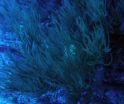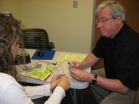Journalists are invited to Frontiers in Optics (FiO) 2010/Laser Science XXVI -- the 94th annual meeting of the Optical Society (OSA), which is being held together with the annual meeting of the American Physical Society (APS) Division of Laser Science at the Rochester Riverside Convention Center in Rochester, N.Y., from Oct. 24-28. Registration details are at the end of this press release.
Many of the presentations at the meeting focus on the most cutting-edge discoveries in applied optics and fundamental physics. Some highlights, described below, include:
1) A Technique that Shows Colorful Connections in the Brain
2) Looking for Osteoporosis with Scattered Light
3) Spotting Suspicious Moles
4) Better Detection for Diagnostics and Biochemical Defense
5) Real-Time Imaging of Stroke Models
6) Direct Laser Cooling of Molecules
7) Making Better Biosensors with Electron Density Waves
8) The Coldest Chemistry
9) Taking a Closer Look at Plaque
10) Best Yet Test of Lorentz Invariance
11) Optofluidics Leads to Better Sensors
Additional research highlights, including new way to treat skin cancer with LEDs, a novel device for imaging brain activity, and energy consumption trends in communication networks, can be found online in the Frontiers in Optics Media Center. http://www.frontiersinoptics.org/MediaCenter/ConferenceNews/default.aspx
1) A TECHNIQUE THAT SHOWS COLORFUL CONNECTIONS IN THE BRAIN
The connections between neurons in a young, growing brain are more dynamic and changeable than previously thought, according to research based on a new technique that reveals the brain circuitry of a living mouse.
A neuron looks a bit like a tree: its branches are dendrites, which accept input and its roots are the axon, which send output. Where axons and dendrites of different neurons come together, they can make connections -- or synapses -- that relay signals and form circuits in the brain.
To study these connections, scientists have traditionally grown networks of neurons in petri dishes -- but there, networks are limited in their ability to mimic brain cells in a living, developing creature. Daniel Kerschensteiner, of Washington University School of Medicine in St. Louis, is one of the first to study connections in the nervous system of living mice, by inserting genes into neurons that cause them to produce fluorescent molecules.
"The novel thing is that we can label specific pairs of pre- and post-synaptic cells and their connections in an intact circuit," said Kerschensteiner. "No one has really done that before."
When energized by the imaging technique called two-photon microscopy, the molecules fluoresce in different colors and reveal the structure and connectivity of brain circuits.
This approach has already yielded some surprising insights. For instance, studies of the neurons in the mouse retina have shown that neural connections can change dramatically fairly late in an animal's development -- in its second week of life, long after the arrangement of axons and dendrites has already been laid down.
In ongoing experiments, Kerschensteiner hopes to further refine science's understanding of how a developing brain reorganizes its connections as it grows -- as well as the internal mechanisms behind this rearrangement and how much it is influenced by an animal's experiences and external environment.
The presentation, "Imaging the Development of Neural Circuits in the Mammalian Retina" is at 4 p.m. on Monday, Oct. 25.
2) LOOKING FOR OSTEOPOROSIS WITH SCATTERED LIGHT
Researchers at the University of Rochester in New York are developing a new way to monitor bone health and search for signs of osteoporosis, using infrared light. At Frontiers in Optics 2010, Jason Maher, Andrew Berger, and their colleagues will present ongoing studies of the effects of steroids on the bones of mice.
Steroids are commonly prescribed for the treatment of rheumatoid arthritis. Glucocorticoids reduce inflammation around the joints and ease pain. But like most treatments, steroids have side effects. Studies have shown that they raise the risk of developing osteoporosis.
One way to study this problem is to treat laboratory mice with steroids and with various interventions meant to counteract the side effect. A key challenge is how to assess a bone's structural integrity. The gold standard, removing the bone and measuring the amount of force needed to snap it in half, can only be performed by sacrificing the animal. Standard X-ray techniques can noninvasively determine bone mineral density, but this has proven to be a poor predictor of fracture risk in humans with steroid-induced osteoporosis.
The Rochester team is developing a new technique that promises to be non-invasive, based on a technique called Raman spectroscopy. By measuring how light scatters off the materials inside bone, they have been able to calculate the relative amounts of mineral and protein matrix of intact bones. They hope to find new and better indicators of bone strength in the chemical information that Raman spectroscopy provides about both the bone mineral and collagen matrix that make up bone.
"Our ultimate goal is to be able to measure the properties of a bone within an intact mouse limb," said Berger. "We hope to develop a better way to spot osteoporosis early in its onset."
The presentation, "Steroid Induced Osteoporosis Detected by Raman Spectroscopy" is at 3:15 p.m. on Monday, Oct. 25.
3) SPOTTING SUSPICIOUS MOLES
Most of the spots on our skin are perfectly harmless moles, collections of cells called melanocytes. But occasionally, these melanocytes turn cancerous, creating the potentially deadly skin tumor melanoma.
At Frontiers in Optics 2010, scientists at Duke University in Durham, N.C., will present a new technique that aims to help doctors distinguish melanomas from harmless moles using high-resolution snapshots of suspicious spots.
To visually inspect the surface of the skin, doctors can use a hand-held lens and a bright light or microscopes and a technique called dermoscopy. But recent studies have found that diagnoses based on these images are often incorrect, because only the surface is visible, and the dangerous changes take place too deep to be seen. "There's quite a bit of variability in the diagnoses provided this way," said Thomas Matthews, a researcher at Duke. The best way to diagnose melanoma is still a biopsy -- the removal and analysis of a chunk of tissue from a growth -- but even then, experienced doctors often disagree on the diagnosis. This disagreement leads to false positives (which force unnecessary procedures and drive up healthcare costs) or false negatives (which can have fatal consequences).
Matthews and his colleagues at Duke's Center for Molecular and Biomolecular Imaging are adapting a laboratory imaging technique to provide new information about suspicious moles, both in vivo and in biopsy specimens. Skin contains two kinds of pigments, or melanins: pheomelanin, which is reddish or yellow, and eumelanin, which is dark and brownish. Some studies have suggested that a change in the ratio of these two pigments could signal that a harmless mole has turned malignant. Matthews' two-photon microscopy technique pumps a small amount of energy into the pigments (using much less power than a laser pointer), then watches the energy redistribute to give high-resolution images of their distributions in a spot of skin.
"No one has been able to look at where different melanins are organized in skin," said Matthews. "This opens up a whole new pathway of looking for melanoma." The most immediate application would be to reduce false positives and false negatives in interpreting biopsies; with further research, the scientists hope to better define how this information can be used to avoid biopsies altogether.
The presentation, "Nonlinear High-Resolution Imaging of Eumelanin and Pheomelanin Distributions in Normal Skin Tissue and Melanoma" is at 8:45 a.m. on Tuesday, Oct. 26.
4) BETTER DETECTION FOR DIAGNOSTICS AND BIOCHEMICAL DEFENSE
Current detection methods for chemical and biological molecules involve using tiny, molecular "labels," typically fluorescent or radioactive entities, which can be a time-consuming and expensive process. A University of Michigan research team headed by Associate Professor Xudong (Sherman) Fan, recently developed a system for detecting chemical and biological molecules without labels, and they expect the technology to have broad applications ranging from clinical diagnostics to drug development, as well as homeland security and environmental monitoring for biological and chemical weapons.
According to Fan, the new method has the additional benefit of not altering the molecules of interest. "We just measure the molecules directly," he says, adding that labeling "is a time-consuming and costly process... and may affect the biological functions of the molecule" being examined.
Fan and his colleagues built their system by adapting an optical sensing device known as a ring resonator, which has greater sensitivity than traditional optical fiber or waveguide sensors. The team partnered the ring device with a capillary-based fluidic system, creating a "unique integration of capillary fluidics with ring resonator technology," according to Fan.
The capillary system can be used for the introduction of either liquid or gas to the sensor, giving the new device a broad spectrum of potential applications. In a clinical diagnostic setting, for example, body fluids such as blood and saliva can be used. Alternatively, vapor analysis can also be performed on exhaled breath for early and non-invasive diagnosis of diseases such as cancers. For homeland security and environmental monitoring purposes, volatile organic compounds, such as explosives, are typically of interest. Particularly for gaseous compounds, most current systems suffer from a lack of specificity. The combined device developed by Fan's group, however, can be built into a so-called "micro GC" (gas chromatography), which enables highly specific identification of compounds.
The talk, "Optical Ring Resonator Based Biological and Chemical Sensors," is at 11 a.m. on Tuesday, Oct. 26.
5) REAL-TIME IMAGING OF STROKE MODELS
One of the major impediments to understanding how brain cells die during a stroke and identifying new ways to protect them has been the long-standing inability to image strokes, or "ischemic events" in living tissue. Now researchers at Cornell University, led by Research Associate Nozomi Nishimura, have developed methods to induce strokes in animal models and image the events as they unfold.
"We can see the dynamics of interaction," Nishimura says, adding that some neurons most likely die due to interactions with many different types of cells, including immune system cells, vascular cells, astrocytes and glial cells. She and her colleagues visualize intercellular dynamics via two-photon excited fluorescence (2PEF) microscopy, which is able to image individual cells and capillaries. Employing relatively long wavelengths of light, Nishimura and her colleagues have succeeded in imaging at greater depths into tissue than has been possible to date.
Nishimura and her colleagues have also developed a method to induce localized lesions within rodent models. They adapted a technology, femtosecond laser ablation, typically used in micromachining of solid materials, for a novel biological use. This ability to induce specific small lesions is particularly important to creating viable models in which to study the progression typical of dementia. According to Nishimura, it is becoming clear that many elderly people suffering from dementia have experienced a series of microstrokes, triggering cumulative damage. "How is it that these small bleeds or blood clots affect neurons?" she asks, adding that the ability to introduce and then image microstrokes in a model system should shed light on how damage might best be mitigated.
The laser ablation system is also being explored for use in surgical manipulation and in examining tumor migration, specifically, how cells shed from tumors might also block blood vessels.
The presentation, "Nonlinear Optical Tools for Studying Small-Stroke at Microscopic Scales" is at 8 a.m. on Tuesday, Oct. 26.
6) DIRECT LASER COOLING OF MOLECULES
Cooling molecules with lasers is harder than cooling individual atoms with lasers. The very process of laser cooling, in which atoms are buffeted by thousands of photons, was thought by many to be impossible for molecules since photons, instead of slowing and cooling the molecules, could actually excite internal motions such as rotations and vibrations. Consequently, to get cold molecules one method is to first cool atoms and then combine them into molecules.
Now Yale physicist David DeMille and his team have developed a way to cool molecules directly with laser light using three lasers instead of the two typically needed for atoms. By choosing the molecular species carefully --they experiment with SrF molecules-- and choosing the photon energies to avoid unwanted excitation of rotational motion, the cooling process can proceed. In this way, molecular temperatures of 300 micro-K have been achieved, the lowest ever for direct cooling of molecules. This temperature pertains so far to motion along one selected dimension only, much as for the initial demonstrations of laser cooling for atoms.
While these temperatures are less than a thousandth of a degree above absolute zero, they are for now orders of magnitude hotter than the cold molecules that can be made by first chilling individual atoms and then combining them. With the latter approach, however, the choice of molecules is presently limited to only those that can be made with alkali atoms. The SrF molecules used in the Yale experiment, by contrast, possess an unpaired electron. This makes them potentially useful as quantum bits or in various studies of fundamental physics. In addition, the results from DeMille's group indicate that laser cooling to yet lower temperatures is likely possible for SrF and other, similar molecules.
"The technique of laser cooling," says DeMille, "which has led to a revolution in atomic physics, has now been shown to also apply to (at least some) molecules. This significantly expands the range of molecules for which ultracold temperatures can be reached, which in turn opens a route to many new scientific applications."
The presentation, "Laser Cooling of a Diatomic Molecule," is at 1:30 p.m. on Thursday, Oct. 28.
7) MAKING BETTER BIOSENSORS WITH ELECTRON DENSITY WAVES
An emerging field with the tongue-twisting name of "optofluidic plasmonics" promises a new way to detect and analyze biological molecules for drug discovery, medical diagnostics, and the detection of biochemical weapons. Investigators at the University of California, San Diego led by Yeshaiahu Fainman have succeeded in merging a microfluidics system with plasmonics -- sometimes called "light on a wire" -- onto a single platform. Plasmonics is based on electron waves on a metal surface excited by incoming light waves.
According to Fainman, tapping the potential of plasmonics for biomolecule detection systems has been a challenge, because localized optical field scales are usually much larger than the molecules in question. In order to make a useful optical biosensor, he says, "We need to increase the interaction cross-section by finding ways to localize optical interrogation fields ideally to the scales comparable to those of biomolecules." Since that is not currently possible, he and his team used an approach of integrating microfluidics and plasmonics on single chips, allowing fluid to ferry the molecules into the cross-section of the optical field.
Fainman expects the system to be particularly useful in studying large arrays of protein-protein interactions for identifying potential drugs that bind to specific target molecules, which may lead to earlier cancer diagnoses and faster discovery of new drugs. Unlike most current methods, optical detection does not require labeling of molecules with fluorescent or radioactive entities -- labels often hinder interaction by covering up or blocking binding surfaces.
The new platform also carries the advantage of being high throughput and multiplexed, offering researchers an opportunity to examine thousands of arrayed compounds simultaneously, which, he says, "biologists and physicians get very excited about."
The presentation, "Optofluidic Nano-Plasmonics for Biochemical Sensing" is at 4 p.m. on Tuesday, Oct. 26.
8) THE COLDEST CHEMISTRY
Chemical reactions tend to slow down as temperature is lowered, but this isn't always true. Deborah Jin,Jun Ye, and their colleagues at the National Institute of Standards and Technology (NIST) and the University of Colorado have shown that chemical reactions can continue even at temperatures just a fraction of a degree above absolute zero. In recent experiments, they took diatomic potassium and rubidium molecules, each in their ground states (lowest-possible energy), and found that when mixed, the molecules dissociated and combined into KRb -- molecules with one potassium and one rubidium atom.
Furthermore, the reaction rates could be slowed considerably by applying an electric field, which orients the molecules in such a way as to suppress chemical reactions. The reason for this is that the KRb molecules are fermions and obey the Pauli Exclusion Principle, just like where two electrons of the same quantum energy and spin are forbidden to lie in a single quantum state – just operated at the level of whole molecules. When applied electric fields oriented the KRb molecules so as to have the same spin state (they would already have the same energy state, being in the ground state to start with) chemical reactions were greatly suppressed. NIST physicist John Bohn has now provided the theoretical underpinnings for the ultracold chemical behavior. He will describe how spin-dependent chemistry, or "stereodynamics," will operate in future experiments.
The Presentation, "Manipulation of Ultracold Chemistry" is at 8 a.m. on Thursday, Oct. 28.
9) TAKING A CLOSER LOOK AT PLAQUE
A team of University of Rochester scientists is using the technique of Raman spectroscopy to study two common dental plaque bacteria, Streptococcus sanguis and mutans. The relative balance of the two may be an indicator of a patient's oral health and risk for tooth decay -- Streptococcus sanguis is associated with "healthy" plaque, while mutans is associated with tooth decay.
Raman spectroscopy offers the potential to analyze samples of the bacterium in a simple, rapid and quantitative manner as compared to microbiology techniques, including the ability to study spatial distributions of bacterial species, living or dead, within samples.
"We're using Raman spectroscopy to study these oral bacterial biofilms, essentially observing how two species scatter light into shifted wavelengths in a unique way. We can then use these characteristic spectra to identify 'unknown' samples of these species," says Brooke Beier, a Ph.D. candidate at the University of Rochester's Institute of Optics. "Studying the spatial distributions of the good vs. bad bacteria under various growth conditions may help scientists determine more effective treatments to prevent tooth decay."
With the ability to identify biofilm samples by species, the researchers can now move on to the study of biofilms grown from a mixture of liquid cultures, where the two species may interact as they grow together.
The talk, "Confocal Raman Microspectroscopy of Streptococcus sanguis and mutans," is at 9:45 a.m. on Tuesday, Oct. 26.
10) BEST YET TEST OF LORENTZ INVARIANCE
The more crucial a physical law is, the more important it is to keep testing it. One of the most important laws formulated in the last century or so is Albert Einstein's principle of invariance, which says that there is no preferred reference system or orientation in the universe. A hypothetical violation of this principle might come about through the intervention of some not-yet-known force field. The field would manifest itself by the simultaneous violation of three basic symmetries in nature, called CPT: charge conjugation (a symmetry which says that nature treats matter and antimatter alike), parity inversion (which says that nature can't differentiate between left and right), and time inversion (a symmetry which holds that movies of microscopic interactions should look alike even if you reverse the order running from front to back). In other words, looking for violation of Lorentz invariance is equivalent to looking for violations of CPT invariance.
Michael Romalis and his colleagues at Princeton look for the faint magnetic influence the hypothetical field would have on matter by watching two species of atoms – potassium and helium-3 – which are contained in a rotating vessel. The whole lab is of course attached to the Earth, which itself rotates daily and orbits the Sun. All of these motions, carefully accounted for, should leave behind a trace of a difference for the two atomic species if an extra field exists.
The result of the latest round of observations improves by a factor of 30 the constraint on the existence of the hypothetical Lorentz-violating field.
"This is a rather dramatic improvement in CPT and Lorentz tests," says Romalis. "Our new technique also has the potential for much larger improvements in the future, so there are more limits to come."
The presentation, "New Limit on Lorentz and CPT Violation for Neutrons," is at 1:30 p.m. on Thursday, Oct. 28.
11) OPTOFLUIDICS LEADS TO BETTER SENSORS
Optofluidics is the marriage of photonics and microfluidics in a lab-on-a-chip setting. Only about a decade old, the subject answers the need for producing all the optical components -- lenses, diffraction gratings, switches, mirrors, microscopes, lasers, and so forth -- needed for processing light waves or photons, but in a liquid environment, specifically in the fluid-filled channels of a microfluidic chip.
Andreas Vasdekis, a scientist at the Ecole Polytechnique Federale de Lausanne, in Switzerland, will report on the effect of surfactants (chemicals at the surface layer between the solid channel and the fluid) on producing a number of optical effects, such as in contriving diffraction gratings for producing laser light in the fluid, or in producing all-optical switching, or in sensing and analyzing DNA and other bio-molecules.
The presentation, "Surface Optofluidics" is at 2:30 p.m. on Tuesday, Oct. 26.
###
About the Meeting
Frontiers in Optics 2010 is OSA's 94th Annual Meeting and is being held together with Laser Science XXVI, the annual meeting of the American Physical Society (APS) Division of Laser Science (DLS). The two meetings unite the OSA and APS communities for five days of quality, cutting-edge presentations, fascinating invited speakers and a variety of special events spanning a broad range of topics in physics, biology and chemistry. FiO 2010 will also offer a number of Short Courses designed to increase participants' knowledge of a specific subject while offering the experience of insightful teachers. An exhibit floor featuring leading optics companies will further enhance the meeting.
Useful Links:
Meeting home page
http://www.frontiersinoptics.org/
Conference program
http://www.frontiersinoptics.com/ConferenceProgram/default.aspx
Searchable abstracts
http://www.abstractsonline.com/viewer/?mkey=%7BD58D07D1%2D61B6%2D42D6%2D8819%2DFCF66F28A08B%7D
EDITOR'S NOTE: A Press Room for credentialed press and analysts will be located in Aqueduct AB of the Rochester Riverside Convention Center, Sunday through Thursday. Those interested in obtaining a press badge for FiO should contact OSA's Lyndsay Basista at +1 202.416.1930 or lbasista@osa.org.
About OSA
Uniting more than 106,000 professionals from 134 countries, the Optical Society (OSA) brings together the global optics community through its programs and initiatives. Since 1916 OSA has worked to advance the common interests of the field, providing educational resources to the scientists, engineers and business leaders who work in the field by promoting the science of light and the advanced technologies made possible by optics and photonics. OSA publications, events, technical groups and programs foster optics knowledge and scientific collaboration among all those with an interest in optics and photonics. For more information, visit www.osa.org.
END




